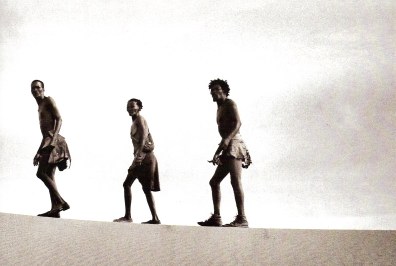|
|
South Africa: Land and People
By Harm J. De Blij
 San Busmen-there are some 250 left in South Africa-have filed a claim to get back land now inside the Kalahari Gemsbok National Park.
The Republic of South Africa is a large country. Its 472,500 square miles compare to those of Texas, Oklahoma, New Mexico, and part of Louisiana. It is more than twice the size of France, yet in subsaharan Africa it is not among the giants. The Congo is more than double the size of South Africa, and Angola, the Central African Federation, and Sudan also exceed it in area. Although large, the country does not have a high total of population. There are just over 46 million people in South Africa, whereas smaller Nigeria has nearly 130 million.
South Africa is also a varied and beautiful country. Extending latitudinally from just over 22° south to nearly 35° at Cape Agulhas, the country partakes of tropical Africa while being lapped by antarctic waters on its southwestern shores. From sea level (and some of the world's most beautiful beaches) it rises to the interior plateau, which culminates in the Drakensberg at Thabana Ntlenyana (11,425 feet). A variety of climates, ranging from true mediterranean at the Cape to tropical in the north and from desert to humid subtropical in the interior and along the coasts respectively, have carved a complex mineralrich geology into some of Africa's most magnificent scenery. On the interior plateau, elevation moderates the other wise excessive heat of the lower latitudes to create a healthy and desirable environment, and pastures on the plateau rank among the best in all Africa.
South Africa is officially a bilingual country. Afrikaans and English have equal rights, and everything official is done in both languages. Official announcements are printed in each language separately, the courts permit the use of either language, and school is taught in one or the other, with lessons given in both. Every signpost, every train station, every post office, and every public facility must carry markers in two languages. After an uphill battle for equal recognition, Afrikaans has now fully asserted itself, which, in view of the power and prevalence of English, is one feature of which Afrikaners are justly proud.
Since a multitude of other languages are of course spoken in the country, to call South Africa bilingual is to understate the case. In Southern Africa, experts have recognized nearly 300 languages and major dialects spoken by Africans, and several of these are spoken by more people than speak Afrikaans or English at home. In South Africa, the most widely spoken African languages are probably Zulu, Xosa, Tswana, South Sotho, North Sotho, Tsonga, and Chivenda. The Asiatics also speak their own languages, and those most commonly heard are Hindi, Tamil, Urdu, Telugu, and Gujerati. Among the Cape Colored people, the Malay language has practically disappeared, and Arabic is taught in only one or two primary schools. The Cape Colored speak either Afrikaans or English.
The present population of Southern Africa is composed of the representatives of several racial groups. Chronologically, the Bushmen and Hottentot peoples preceded all the others. Known as the Khoisan peoples of Southern Africa, the Bushmen first and the Hottentots subsequently occupied most of the subcontinent. Today, neither people survives in great numbers. There are perhaps 10,000 remaining Bushmen, scattered through the drier parts of the region. Perhaps many centuries ago they numbered in the hundreds of thousands, but even before the first white men set eyes upon Southern Africa, the Bushmen were being driven into the most remote and inhospitable parts by their immediate successors on the local stage, the Hottentots.
Source: Africa South
|
|
This website is created and designed by Atlantis International, 2006
This is an unofficial website with educational purpose. All pictures, and trademarks are the property of their respective owners and may not be reproduced for any reason whatsoever. If proper notation of owned material is not given please notify us so we can make adjustments. No copyright infringement is intended.